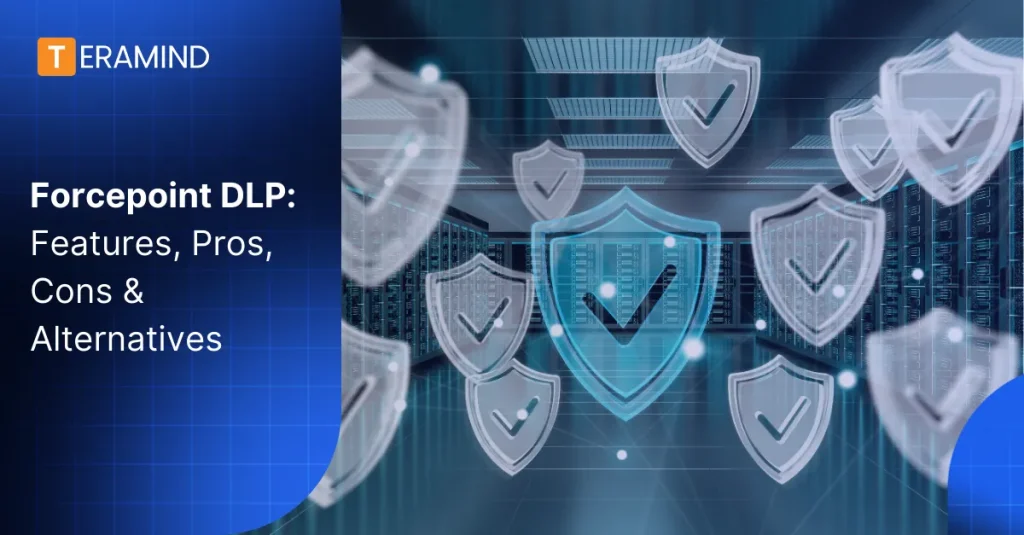Data Loss Prevention (DLP) has become a critical component of modern cybersecurity strategies. Forcepoint’s DLP platform offers a robust solution for organizations seeking to protect sensitive data from unauthorized access and exfiltration. While it excels in providing comprehensive data protection across various channels, users may find the initial setup process complex and time-consuming. Additionally, some organizations may experience endpoint performance impacts during deep content inspection.
What is Forcepoint DLP?
Forcepoint DLP is an advanced data protection platform that discovers, monitors, and secures sensitive information across an organization’s IT environment. It provides a centralized console for consistently defining and enforcing security policies, whether data is at rest, in motion, or in use.
One of Forcepoint DLP’s key differentiators is its focus on understanding user behavior and risk. It applies analytics to identify and prioritize high-risk activity, enabling security teams to respond to potential data theft proactively. Forcepoint DLP also provides employee coaching and education to guide the proper handling of sensitive information.
Pros and Cons
| Pros | Cons |
| Comprehensive data protection across multiple channels | Complex initial setup and configuration |
| Advanced machine learning for accurate data classification | Potential performance impact on endpoints |
| Flexible policy creation and enforcement | No remote desktop control |
| Robust reporting and analytics capabilities | Captures screenshots but doesn’t record screens |
| Strong incident response and remediation features | Resource-intensive for full deployment |
Key Features and Components
Data Discovery and Classification
Forcepoint DLP employs advanced data discovery and classification techniques to identify and categorize sensitive information across an organization’s network.
- Machine learning-based classification: Utilizes AI to accurately identify and categorize data based on content and context.
- Custom classification rules: Allows organizations to create tailored rules for specific data types or industry regulations.
- Automated scanning: Continuously scans endpoints, servers, and cloud storage for sensitive data.
Disadvantages
While Forcepoint’s data discovery and classification capabilities are robust, they can be resource-intensive, potentially impacting system performance during deep scans. Additionally, the initial setup of custom classification rules may require significant time and expertise to ensure accuracy and avoid false positives.
Forcepoint DLP focuses primarily on data discovery and enforcement, with less emphasis on user activity monitoring. While it does provide some visibility into user actions, the depth of monitoring may not be enough for organizations looking to detect and investigate insider threats. Customers may need to supplement Forcepoint DLP with a separate user activity monitoring solution.
Policy Management and Enforcement
Forcepoint DLP offers flexible policy creation and enforcement options to protect sensitive data across various channels and use cases.
- Granular policy controls: Enables the creation of highly specific policies based on data type, user, device, and more.
- Pre-built policy templates: Provides industry-specific templates to accelerate deployment and ensure compliance.
- Real-time policy enforcement: Applies policies in real-time to prevent data loss incidents before they occur.
Disadvantages
The granular nature of Forcepoint’s policy management can lead to complexity, especially in large organizations with diverse data protection needs. This complexity may result in longer implementation times and require dedicated resources for ongoing policy management and optimization.
Network DLP
Forcepoint’s network DLP capabilities monitor and protect data in transit across various communication channels.
- Email monitoring: Scans outgoing emails and attachments for sensitive content.
- Web traffic inspection: Analyzes HTTP/HTTPS traffic for potential data exfiltration attempts.
- File transfer protocol (FTP) monitoring: Monitors FTP transfers to prevent unauthorized data transfers.
Disadvantages
While network DLP is a crucial component of data protection, it may introduce latency in network communications, particularly when deep content inspection is enabled. Organizations with high-volume, low-latency requirements may need to balance security and performance considerations carefully.
Endpoint DLP
Forcepoint’s endpoint DLP solution provides protection for data at rest and in use on individual devices.
- Device control: Manages the use of removable storage devices and peripherals.
- Application control: Restricts the use of specific applications that may pose a data loss risk.
- Clipboard monitoring: Prevents unauthorized copying and pasting of sensitive information.
Disadvantages
Endpoint DLP can sometimes impact end-user experience, particularly on older or less powerful devices. The need for agent installation on each endpoint can also increase management overhead and may require additional resources for deployment and maintenance.
While Forcepoint DLP does offer some user and entity behavior analytics (UEBA) features, they are relatively basic compared to dedicated UEBA solutions. Machine learning focuses on identifying sensitive data rather than analyzing a broad range of user activities. Organizations looking for advanced user behavior monitoring may need a separate UEBA tool.
Forcepoint DLP can capture screenshots of user activity for forensic analysis and incident response. However, it does not provide full-screen recording capabilities. This means security teams cannot playback a video of exactly what a user did leading up to a data loss event. Screenshots offer helpful context but may not paint a complete picture.
Incident Management and Response
Forcepoint DLP includes robust incident management and response capabilities to help organizations quickly identify and address potential data loss events.
- Customizable alerts: Allows for the creation of tailored alerts based on specific risk scenarios.
- Automated incident response: Enables the configuration of automated actions for common incident types.
- Forensic analysis tools: Provides detailed forensic information to support incident investigation.
Disadvantages
The wealth of incident data provided by Forcepoint DLP can sometimes lead to alert fatigue if not properly tuned. Organizations may need to invest time in fine-tuning alert thresholds and response workflows to avoid overwhelming security teams with false positives or low-priority incidents.
How Forcepoint DLP Compares to Teramind
Let’s compare Forcepoint DLP to Teramind and see how they compare.
Areas Where Teramind Excels
View Teramind’s Live Demo.
- User Activity Monitoring: Teramind offers more comprehensive user activity tracking, including screen recordings and keystroke logging.
- Productivity Analysis: Teramind provides detailed insights into employee productivity and application usage patterns.
- Insider Threat Detection: Teramind’s behavior analytics are more advanced in identifying potential insider threats.
- User-Friendly Interface: Teramind’s interface is generally more intuitive and easier to navigate for non-technical users.
- Rapid Deployment: Teramind typically offers a faster deployment process compared to Forcepoint DLP.
How Teramind Stands Out
Behavior-Based Analytics
Teramind’s behavior-based analytics go beyond traditional DLP by analyzing user actions and patterns to identify potential risks. This approach allows for more proactive threat detection and can help organizations prevent data loss incidents before they occur.
The system uses machine learning algorithms to establish baseline behavior for individual users and departments, then alerts on deviations from these norms. This capability is particularly useful for detecting insider threats that might not trigger traditional DLP rules.
Live View and Remote Actions
Teramind’s live view feature offers real-time visibility into user activities. This allows administrators to observe user actions as they happen and take immediate action if necessary.
The remote actions capability enables administrators to intervene directly on a user’s machine, such as terminating processes or locking the screen. This feature can be crucial for stopping data loss incidents in progress or providing immediate support to users.
Time and Attendance Tracking
Unlike traditional DLP solutions, Teramind includes robust time and attendance tracking features. This functionality allows organizations to monitor employee work hours, track project time, and analyze productivity metrics.
The time tracking feature integrates seamlessly with Teramind’s other monitoring capabilities, providing a comprehensive view of employee activities and their impact on productivity and security.
Why You Should Choose Teramind
- Comprehensive Insider Threat Protection: Teramind’s behavior analytics and user activity monitoring provide superior protection against insider threats compared to traditional DLP solutions.
- Improved Productivity and Operational Efficiency: The combination of DLP features with productivity tracking tools allows organizations to optimize their workforce while maintaining strong data protection.
- Faster Time-to-Value: Teramind’s intuitive interface and rapid deployment options enable organizations to implement robust data protection measures more quickly than with complex DLP solutions like Forcepoint.
- Flexible Deployment Options: Teramind offers both cloud-based and on-premises deployment options, providing greater flexibility for organizations with specific infrastructure requirements or compliance needs.
- Continuous Innovation: Teramind’s focus on user behavior and activity monitoring positions it at the forefront of evolving security threats, potentially offering better long-term value as the threat landscape continues to change.


